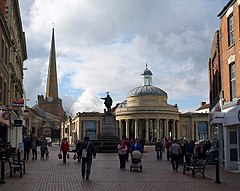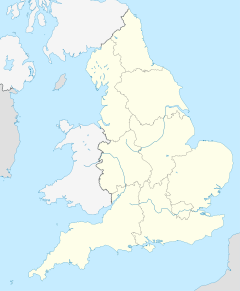Bridgwater
| Bridgwater | ||
|---|---|---|
| Bridgwater: St Mary's Church , rotunda of the covered market and statue of Admiral Blake | ||
| Coordinates | 51 ° 8 ′ N , 3 ° 0 ′ W | |
| OS National Grid | ST305370 | |
|
|
||
| Residents | 36,079 (as of 2010) | |
| surface | 13.58 km² (5.24 mi² ) | |
| Population density: | 2657 inhabitants per km² | |
| administration | ||
| Post town | BRIDGWATER | |
| prefix | 01278 | |
| Part of the country | England | |
| region | South West England | |
| Shire county | Somerset | |
| District | Sedgemoor | |
| Website: Bridgwater Town Council | ||
Bridgwater is a town of about 36,000 people in south-west England. It lies at an altitude of 5 to 15 m above sea level on the River Parrett in Somerset and belongs to the Sedgemoor district , of which it is the capital.
Industry
During the Second World War, the nearby Royal Ordnance Factory (ROF) Bridgwater munitions factory was important. This is where the Somerset Brick & Tile Museum is located. Bridgwater is the headquarters of the beverage manufacturer GerberEmig Group . 12 km northwest of Bridgwater, on the coast, is the Hinkley Point Nuclear Power Plant ; it has been in operation since 1965.
carnival
At the beginning of November (on the first Friday and Saturday) a carnival takes place here every year, which is known as the largest celebration of its kind outside of the carnival season. The carnival originated in the 18th century to celebrate the gunpowder conspiracy (one of the perpetrators, Robert Parsons, was associated with the city). The event has been organized every year since 1880. In 2007 it attracted around 20,000 spectators. This makes it one of the county's biggest attractions.
Town twinning
sons and daughters of the town
- Robert Blake (1598-1657) - English admiral
- James Sully (1842-1923) - psychologist
- Cuthbert Dukes (1890–1977) - doctor, pathologist, and writer


